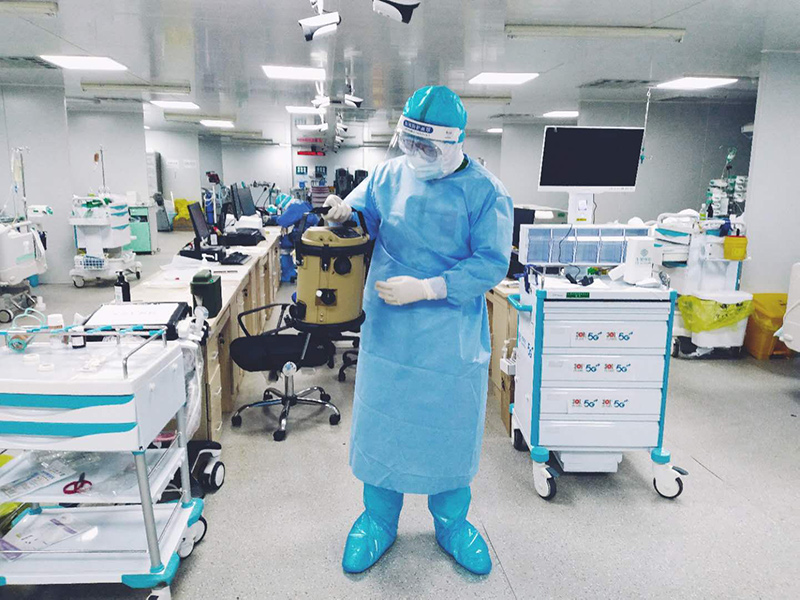Research International Instruments and Coronavirus Research

Our flagship line of SASS® smart air samplers have proven their value in Coronavirus research world-wide. Read on below to see how researchers in Singapore and Wuhan have made news using our instruments.
SASS 3100® Air Samplers Aid in Environmental Genomics and Surveillance
Tracking SARS-CoV-2 and other pathogens in air, on surfaces, and in wastewater
February 2023 - In the Singapore Centre for Environmental Life Sciences Engineering Genomics & Surveillance Project, the SCELSE air microbiome team adapted its bioaerosol analysis protocols and knowhow for the surveillance and analysis of airborne SARS-CoV-2, deploying its fleet of more than 40 air samplers across Singapore. Techniques are also being developed to monitor other pathogens, such as dengue, with the goal of controlling disease outbreaks.
SASS 3100® Air Sampler Pivotal in Developing New COVID Detection Method

November 2021 - Research International's SASS 3100 dry air samplers are playing a key role in a new, more effective method of airborne SARS-CoV-2 detection. In September, a team of doctors and scientists at two Singapore universities published a study using SASS 3100® samplers to collect ambient viral RNA. Test results showed much higher rates of detection than the surface swab sampling methods in use. The new technique could provide early warning when the virus is present, valuable in monitoring high-risk areas such as nursing homes and hospitals.
Read the study: Ang AXY, Luhung I, Ahidjo BA, et al. Airborne SARS-CoV-2 surveillance in hospital environment using high-flowrate air samplers and its comparison to surface sampling. Indoor Air. 2021;00:1–10.SCELSE press release: “Singapore research team uses indoor air sampling surveillance to sniff out COVID-19” Related video
NTU news article: "Using indoor air sampling surveillance to sniff out COVID-19"
Channel News Asia story: “NUS, NTU scientists and doctors develop new way to detect COVID-19 viral RNA in the air”
SASS 2300® Air Sampler Collects Key Information in Wuhan Study

July 2020 - The CDC's monthly journal Emerging Infectious Diseases published a 2020 study, now widely cited, which suggested that six feet is not nearly enough “social distance.” Using Research International SASS 2300® air samplers in hospital wards in Wuhan, China, the authors found that airborne Coronavirus virions can travel as much as four meters, or about 13 feet. Read the complete article here:
Guo Z, Wang Z, Zhang S, et al. Aerosol and Surface Distribution of Severe Acute Respiratory Syndrome Coronavirus 2 in Hospital Wards, Wuhan, China, 2020. Emerging Infectious Diseases. 2020;26(7):1583-1591. doi:10.3201/eid2607.200885.CDC.gov (www.cdc.gov) is the official website of the Centers for Disease Control and Prevention (CDC). More information about Coronavirus
SASS 2300 Sampler Selected for Commercial Bioaerosol Monitoring

Criterion Labs is one of the companies that have selected the SASS 2300 for COVID-19 monitoring. See their Coronavirus field services page for more information.
Disinfectant Products for SARS-CoV-2

Research International now offers two powerful yet safe disinfectants. Both are tested and proven to kill SARS‑CoV‑2, but are safe for people, property, and the environment.
Spectra DF-500 two-part disinfectant destroys bacteria, viruses, algae, and fungi.
Spectra DF-200 three-part disinfectant destroys the same harmful pathogens as DF-500, and also neutralizes toxic chemicals.
SASS® Air Samplers: Relied on by Scientists Everywhere
Our SASS 2300 and SASS 3100 air samplers are in use around the world wherever researchers are studying airborne pathogens. Some typical applications include study of the air in subways, outdoor air in polluted urban areas, meat processing plants, waste water management plants, and livestock and poultry farm facilities. Below is a partial reading list of studies where our products were employed.
- Quantification of airborne dust, endotoxins, human pathogens and antibiotic and metal resistance genes in Eastern Canadian swine confinement buildings. Pilote, J., Létourneau, V., Girard, M. et al. Aerobiologia volume 35, pages 283–296 (2019)
- Airborne Dispersion of Leptospirosis in a Meat Processing Plant. McLean D, leblanc-Maridor M, Hall R, et al. Occupational and Environmental Medicine 2018; 75:A213.
- Environmental air sampling to detect exotic Newcastle disease virus in two California commercial poultry flocks. Sharon K. Hietala, et al. J. Vet. Diagn. Invest., 17, 198 (2005)
- Human viral pathogens are pervasive in wastewater treatment center aerosols, Evelyne Brisebois et al. Journal of Environmental Sciences, Volume 67, May 2018, Pages 45-53.
- A label-free impedimetric aptasensor for the detection of Bacillus anthracis spore simulant, Vincenzo Mazzaracchio et al. Biosensors and Bioelectronics Volume 126, 1 February 2019, Pages 640-646.
- Study on the distribution law of microbial aerosol in the environment of dairy barn. Sun Hongqi, Jilin Agricultural University S823.4, 2017.
- Two Community Clusters of Legionnaires’ Disease Directly Linked to a Biologic Wastewater Treatment Plant, the Netherlands, Anna D. Loenenbach et al., Emerg Infect Dis. 2018 Oct; 24(10): 1914–1918. doi: 10.3201/eid2410.180906
- Composition and Distribution Analysis of Bioaerosols Under Different Environmental Conditions. Wang, Z., Li, J., Qian, L., Liu, L., Qian, J., Lu, B., Guo, Z., J. Vis. Exp. (143), e58795, doi:10.3791/58795 (2019)



